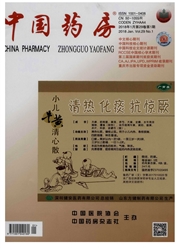

 中文摘要:
中文摘要:
目的:研究甘草对大鼠体内雷公藤甲素(TPL)和雷公藤内酯酮(TPN)内源代谢物水平的影响。方法:取160只大鼠ig甘草[30 g(生药)/kg]2 h后ip TPN(2.8 mg/kg),连续30 d,收集24 h尿液,合并30 d尿液,采用柱色谱技术和波谱技术分离鉴定其内源代谢物;并采用超高效液相色谱-高分辨飞行时间质谱联用法(UPLC-Q-TOF/MS)确定TPL给药后是否具有共同代谢物。将60只大鼠随机分为TPL空白组、TPL组、甘草+TPL组、TPN空白组、TPN组、甘草+TPN组,各给药组大鼠给药方式及剂量同上,TPL空白组和TPN空白组大鼠分别ip相应溶剂,每天1次,连续7 d;采用UPLC-Q-TOF/MS法研究甘草对大鼠体内TPL、TPN内源代谢物水平的影响。结果:从TPN给药大鼠尿液中共分离出5个内源代谢物,分别鉴定为1-甲基海因、4-氨基烟酸甲酯、3,4-二氢-6-羟基-2-喹啉酮、2,6-二羟基喹啉、2-喹啉酮;TPL给药后大鼠尿液中同样存在这5种代谢物。TPL组大鼠尿液中1-甲基海因水平较TPL空白组显著升高(P〈0.05),TPN组大鼠尿液中2,6-二羟基喹啉水平较TPN空白组显著升高(P〈0.05);TPL或TPN联合甘草用药后血清中1-甲基海因、2,6-二羟基喹啉水平均降低,较其空白组差异无统计学意义(P〉0.05)。结论:本实验首次从TPL和TPN给药大鼠尿液中分离鉴定出了5个内源代谢物;甘草能回调TPL给药大鼠尿液中1-甲基海因水平以及TPN给药后大鼠尿液中2,6-二羟基喹啉水平。
 英文摘要:
英文摘要:
OBJECTIVE: To study the effects of Glycyrrhiza uralensis on endogenous metabolites levels of triptolide (TPL) and triptonide (TPN) in rats. METHODS: 160 rats were given G. uralensis [30 g (crude drug)/kg] intragastrically, 2 h later given TPN (2.8 mg/kg) intraperitoneally for consecutive 30 d. 24 h urine were collected for 30 days, and then endogenous metabolites were separated and identified by column chromatograph and spectrum technology. UPLC-Q-TOF/MS was used to determine the common metabolites after giving TPL. 60 rats were randomly divided into TPL blank group, TPL group, G. uralensis+TPL group, TPN blank group, TPN group, G. uralensis+TPN group. Route of administration and dosage of treatment groups were same as above groups. TPL blank group and TPN blank group were given corresponding solvent, once a day, for consecutive 7 d. UPLC-Q-TOF/MS was used to determine the endogenous metabolites of TPL and TPN in rats. RESULTS : Five endogenous metabo- lites were isolated and identified from urine of rats after given TPN, as 1-methylhydantoin, methyl 4-aminonicotinate, 3,4-dihy- dro-6-hydroxy-2 (1H)-quinolinone, 2,6-quinolinediol, 2-quinolone, respectively. Those five metabolites were also found in urine of rats after giving TPN. 1-methylhydantoin in TPL group and 2,6-quinolinediol in TPN group were significantly increased, compared with TPL blank group or TPN blank group (P〈0.05) ; while urine levels of 1-methylhydantoin and 2,6-quinolinediol decreased after TPL or TPN combining with G. uralensis, compared with TPL/TPN blank group, with no significant difference (P〉0,05). CONCLUSIONS: The above five endogenous metabolites were isolated from rat urine after given TPL or TPN for the first time. The levels of 1-methylhydantoin after giving TPL and 2,6-quinolinediol in urine after giving TPN can be recovered by G. uralensis.
 同期刊论文项目
同期刊论文项目
 同项目期刊论文
同项目期刊论文
 期刊信息
期刊信息
